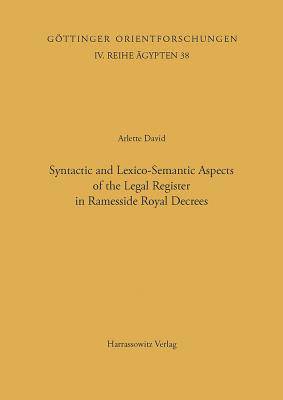
- Afhalen na 1 uur in een winkel met voorraad
- Gratis thuislevering in België vanaf € 30
- Ruim aanbod met 7 miljoen producten
- Afhalen na 1 uur in een winkel met voorraad
- Gratis thuislevering in België vanaf € 30
- Ruim aanbod met 7 miljoen producten
Zoeken
Syntactic and Lexico-Semantic Aspects of the Legal Register in Ramesside Royal Decrees
Arlette David
Paperback | Engels
€ 175,95
+ 351 punten
Omschrijving
Analysis of the legal register of a corpus of some fifty Ramesside royal decrees dating from 1300 to 1100 B.C. in the wider context of forensic discourse analysis of the legislative genre, in an attempt to establish constants in forensic linguistics that span time and space. The general character and formulation of these normative documents reveal a remarkable homogeneity and represent a specific linguistic register that has a common textemic, pragmatic, and narratologic structure, as well as a coherent syntactic and lexico-semantic usage, as modern legal dialects do today. Furthermore, the research tries to enrich the understanding of Egyptian legal terminology and legal categories by a systematic semantic analysis of the classifiers used in the legal lexicon (classifiers in the hieroglyphic system represent iconic elements that have no phonetic value, but assign words to semantic classes). The extremely interesting Egyptian graphic categorization set of classifiers present in these texts offers some invaluable insights into the Egyptian conceptual organization system.
Specificaties
Betrokkenen
- Auteur(s):
- Uitgeverij:
Inhoud
- Aantal bladzijden:
- 313
- Taal:
- Engels
Eigenschappen
- Productcode (EAN):
- 9783447052320
- Verschijningsdatum:
- 1/12/2006
- Uitvoering:
- Paperback
- Formaat:
- Trade paperback (VS)
- Afmetingen:
- 170 mm x 239 mm
- Gewicht:
- 511 g

Alleen bij Standaard Boekhandel
+ 351 punten op je klantenkaart van Standaard Boekhandel
Beoordelingen
We publiceren alleen reviews die voldoen aan de voorwaarden voor reviews. Bekijk onze voorwaarden voor reviews.








